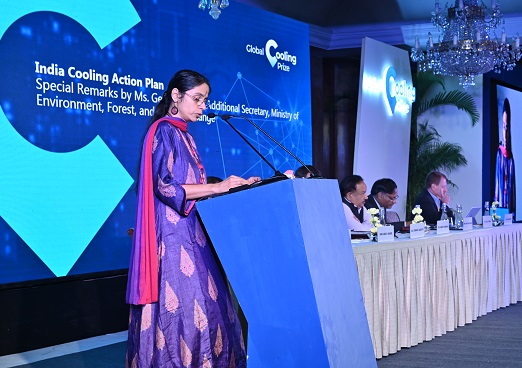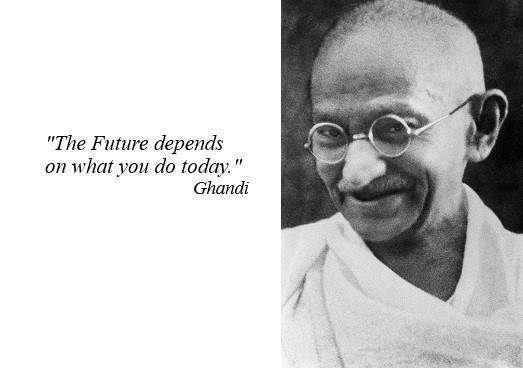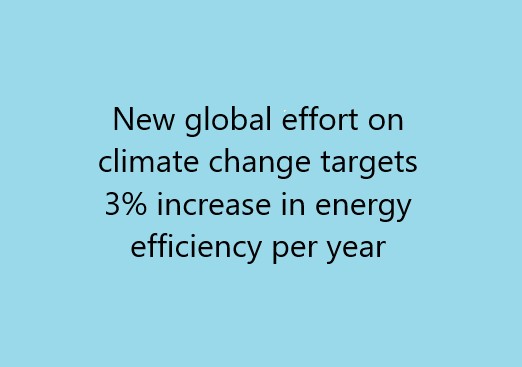Thursday 5 December 2019
On the 15th November I was privileged to be in the opulence of the Taj Mahal hotel in Delhi with several hundred honoured guests, delegates and entrants gathered from all over the world for an event that addressed one of the biggest drivers of how our climate future turns out, the growth of demand for cooling and how to meet that demand sustainably.
It is only in the last few years that the importance of cooling has been recognised by energy and climate professionals, that solving the sustainable cooling problem is absolutely critical if we are going to successfully address climate change. Several mega-trends are in play. Population growth, income growth, urbanisation and a warming planet will lead to an increase in cooling demand that multiples by four by 2050 under BAU. Sales of Room Air Conditioners (RACs) are growing at 10 to 15% per annum which means that by 2050 the number of RACs in the world will go from 1.2 billion today to 4.5 billion. At current efficiency levels the additional electricity demand from this growth would be equivalent to the current demand from the US, Germany and Japan combined. Cooling also increases peak demand which traditionally drives investment in new generating capacity. In emerging economies, many of which are in hot climates, the demand for space cooling increases with increasing wealth. Urbanisation is increasing, 68% of the global population is expected to live in cities by 2050, up from 55% today, which will increase the heat island effect. Space cooling is not just an issue of comfort, it is increasingly a matter of life and death. Already, 30 percent of the world’s population is exposed to potentially dangerous heat conditions; by 2100, up to three-quarters could be at risk. Affordable and sustainable cooling is a global necessity, allowing for increased productivity, positive health outcomes, and accelerated economic development. As well as more demand for space cooling increasing wealth brings it with an increased use of cold chains.
The problem is best illustrated by India which was the first country in the world to devise a national Cooling Action Plan. The BAU scenario shows that national cooling demand will grow 8 times by 2037/38 with building sector cooling demand growing nearly 11 times. The incremental energy usage just for RACs would be 247.5 TWh (for comparison UK power usage in 2018 was 333 TWh), requiring construction of many new power stations. This is not sustainable in terms of the environment or capital requirements. India also graphically shows the issue of cold chains, only 4% of food produce is transported in cold chains whereas in the UK it is over 90%. This leads to c.£13 billion worth of vegetables, meat, fish and dairy products being wasted, contributing to food shortages and reduced farmer incomes. As well as improving food supplies cold chains improve health through preserving medicines. With its national Cooling Action Plan and heavy involvement in the Cooling Prize, India really is ‘ground zero’ for addressing this problem.
So how do we address the problem? Business As Usual won’t do it and innovation is sorely needed. The air conditioning industry has always focused on reducing capital costs and there have been incredible achievements in cost reduction but unlike other consumer products such as TVs, cars, and communications, there has been no disruptive innovations in air conditioning since the development of vapour compression cycle technology and the first air conditioning installation in 1902 by Mr Carrier. The Global Cooling Prize, initiated by Rocky Mountain Institute (RMI) is supported by a range of organisations including the Government of India, Mission Innovation, several foundations and the Indian Alliance for an Energy Efficient Economy amongst others. It was designed to find and support disruptive innovation. The target was to find new cooling technologies with very specific, and very demanding targets – starting with a reduction in overall global warming impact by a factor of five, as well as much lower power demand and lower water use.
Over 2,100 registrations were received from 96 countries and 139 detailed technical submissions were received from 31 countries. Eight finalists were unveiled at the November meeting.
The prize offered up to $200,000 per finalist for development work and up to $1m for the final winner (to be announced in November 2020). As Iain Campbell of RMI, one of the driving forces behind the Prize said, the announcement of the finalists moved the process from “tell me what you can do” to “show me what you can do”. The selected finalists will now have to produce prototypes that will undergo a rigorous testing process in India, including in actual apartments. The eight finalists have a range of technologies, some of which were based on existing technologies and some on completely new technologies. Entrants ranged from consortia including some of the world’s biggest air conditioning manufacturers, to start-ups and University spin-offs.
The Kigali Amendment to the Montreal Protocol aims to reduce the use of hydrofluorocarbons (HFCs) by 80% over the next 30 years and if fully implemented the Amendment would reduce carbon emissions from air conditioning from c.5 Gt to c.3 Gt. If the Cooling Prize targets were achieved it could reduce that to c.1Gt. This would be equivalent to making the European Union carbon neutral tomorrow.
The Global Cooling Prize is a great project and like the X Prizes for spaceflight and other areas it shows the power of prizes. To quote Iain Campbell again, “the beauty of prizes is that instead of looking for a needle in a haystack the needle comes to you”. It is likely that many of the finalists, and other entrants, may end up with viable products, not just the final winner. We clearly need to ensure that multiple solutions are in development and that there is an eco-system of early stage capital and mentorship for the early stage businesses, as well as scale-up capital when needed. We should all follow the Global Cooling Prize with great interest.

Friday 8 November 2019
Net Zero as a target is very clear – net zero carbon emissions by 2050. The old adage about setting targets comes to mind, is it SMART i.e. Specific, Measurable, Attainable (or sometimes quoted as Agreed upon), Realistic and Time based? It is certainly specific, measurable and time based. Is it attainable and realistic? Time will tell.
For people to adopt a target requires it to be motivating. Net Zero is, or should be highly motivating given the scientific evidence of the potential climate consequences if we don’t restrain emissions. A number of senior business people have reported being motivated to action by questioning from their children and grandchildren about what they are doing to avert a climate crisis and there is probably no better motivator. To seriously adopt a target, rather than just paying it lip service, requires leaders of all types of organisations, from the largest to the smallest, to stand up and take a clear position, define a clear path of action and, critically, actually commit resources to following that path.
What does net zero by 2050 i.e. in the next 30 years, really mean in practice? As Michael Leibrich has pointed out the 30 years between now and then spans two business cycles and markets and businesses change a lot in two cycles. Think back to how different the world was in 1990. In 1989 the world’s first dial-up ISP came to the market and only 0.5% of the world’s population were ‘on-line’ (at least while dialing up!). Renewables were ‘alternative energy’ and you could fit the entire UK wind ‘industry’ in one small room (and we did).
So if we take the idea that we have two business cycles to achieve net zero what do we need to do in this investment cycle? For many users such as hospitals looking at major Energy Performance Contract (EPC) upgrades it is important to fully review alternative technologies to the normal gas fired Combined Heat and Power (CHP) such as heat pumps, but the reality in many cases is that the technology and economics are not quite there yet. By the second investment cycle it will almost certainly be available and viable so adopting the best option for carbon reduction and achieving 30-50% is a sensible strategy. It is also important to consider more radical options like deep fabric retrofits to reduce demand by 70-90%. These are generally regarded as not viable but with a combination of proper integrated design and better business cases that properly value all the benefits, including non-energy benefits such as better patient outcomes, may tip the balance. To even consider and evaluate these options however, let alone develop and implement them, requires strong leadership and capacity building amongst clients and the supply side.
There are examples of even large organisations moving even quicker towards net zero. The case of Orsted (formerly DONG) is certainly inspiring. The company has moved from an oil and gas company to a renewables company in about a decade. In 2010 half of its earnings came from exploration and production or thermal generation and the rest came from sales, distribution and trading. About 70% of its generating plant burnt oil, gas or coal. By 2017 when the company changed its name 70% of the generating fleet was renewables, biomass or waste and by 2020 this is expected to reach 90%. The company has sold off its oil and gas assets and its carbon intensity has fell from 450 g/kWh to 150 g/kWh between 2007 and 2017 (and has since fallen further). Interestingly, EBITDA and market cap have increased more than the six largest independent European oil and gas companies who were considered their peers, and the company has maintained an increasing dividend. This transformation in a decade is nothing short of amazing and the management of Orsted have shown true leadership. Turning round any multi-billion euro/pound/dollar corporate is difficult, as they say it is like turning a super tanker, but the Orsted example shows it can be done and puts many others to shame.
We have the technologies to reach net zero. The motivation is clear. The economic case is stronger than ever and getting better, especially once people look at all benefits. The missing element in reaching net zero is real leadership, leadership at every level from national and local politicians and boards of major companies down to SMEs.

Wednesday 9 October 2019

September saw the launch of the Three Percent Club, a coalition of countries, businesses and international organisations committed to driving a three percent improvement in global energy intensity each year. Launched at the UN Climate Action Summit in New York, the Three Percent Club seeks to address the fall in the annual improvement in energy intensity to just 1.3% in 2018, and International Energy Agency research showing that the right efficiency policies could deliver over 40 percent of the emissions cuts needed to reach the goals of the Paris Agreement, without requiring new technology.
So how do we achieve this annual level of improvement in energy efficiency? Improving energy efficiency fundamentally comes from three things;
- improving the efficiency of existing assets – the buildings, processes and systems we already have – through improved energy management (without significant investment into new equipment).
- improving the efficiency of assets and systems through investment into energy efficiency, investment that can either be purely driven by the desire to improve efficiency (retrofit), normal end of life upgrades (renovation), or investment in new facilities such as buildings and industrial processes.
- changing the mix of the economy to more energy efficient goods and services.
To improve energy management of the existing assets we need to improve training in energy management and increase appreciation of the value of good energy management in the C-suite. Systems such as ISO 50001 can help do this. Policy measures should encourage the use of ISO 50001, through mechanisms such as Ireland’s Large Industry Energy Network, the US’s Superior Energy Performance programme or Sweden’s programme for Improving Energy Efficiency in Energy-Intensive Industry which provides a waiver on energy tax for companies that implement ISO50001 and other measures. We also have to recognise that in many organisations energy management is under-staffed and so the use of newly emerging AI systems to optimise energy use in buildings and processes will become more attractive as they get cheaper and more capable.
Clearly we need to increase the rate of investment into energy efficiency in all forms but we also need to improve the quality of energy efficiency investments. Quality is improved by using standardised, state of the art, project development methodologies such as the Investor Confidence Project’s Investor Ready Energy Efficiency™ to develop projects that perform better. We can increase the depth of savings from investments by adopting integrated design techniques, an approach that is still woefully under used.
We also have to recognise that there are limits to how far any building or process can be improved by retrofitting. End of life renovation provides an opportunity to improve efficiency, an opportunity that is often missed or under-used. Once a major renovation happens the fundamental level of energy efficiency is locked in for a long period, twenty to thirty years or even more. It is critical that we make the most of each and every one of those opportunities to maximise the improvement in energy efficiency. This requires several things; policies that drive maximum efficiency, and building capacity in the C-suite to ensure customers demand the highest levels of efficiency. A third important factor would be banks and financial institutions lending for these kinds of projects working to ensure higher levels of efficiency than simply ‘business as usual’ are achieved. Banks such as ING commercial property division already do this by providing assistance and refusing to lend to low performing buildings. ING and other financial institutions see this as a risk reduction strategy, a way of generating additional business and a way of having an environmental impact. For building and industrial process owners just building a new facility to legal requirements (either planning requirements or even current best practice) and claiming it as energy efficient is not good enough, owners need to demand the highest levels of efficiency and low carbon energy supply – this does not mean untested technology, just using existing technology in the best way.
We need to build capacity on the demand side, the supply side and in the finance community. We need to ensure the C-suite knows what is possible and actually demands high quality energy management programmes, high quality investments into efficiency and the use of integrated design. Leading companies including Johnson Controls, Schneider Electric and 3M have achieved more than 3% improvement in energy productivity per annum year after year, in some cases for several decades so it can be done. We also need to build capacity in the financial sector to understand, evaluate and invest into energy efficiency.
Changing the mix of the economy to more energy efficient goods and services is another area that we should not forget. Dematerialisation and integration of devices e.g. smart phones replacing cameras, radios and just about everything else, helps. Switching to renewable energy supplies greatly helps as the inherent inefficiency of thermal power stations – driven by the laws of thermodynamics – is replaced by direct generation with no thermal processes with their massive losses.
The Three Percent Club is a way of focusing attention on the problem with a clear target against which progress can be measured. EnergyPro supports this new initiative fully – if you want to support it too you can sign up here.
Friday 6 September 2019
For anyone wanting to understand how the world changes Thomas Kuhn’s concept of paradigm shifts, as put forward in his 1962 book ‘The Structure of Scientific Revolutions’, is essential reading, even though it was originally applied to shifts in scientific thinking it is applicable far beyond science.
In its entry on Kuhn, the Encyclopaedia Britannica explains his concept:
“Scientific research and thought are defined by ‘paradigms’, or conceptual world-views, that consist of formal theories, classic experiments, and trusted methods.
“Scientists typically accept a prevailing paradigm and try to extend its scope by refining theories, explaining puzzling data, and establishing more precise measures of standards and phenomena. Eventually, however, their efforts may generate insoluble theoretical problems or experimental anomalies that expose a paradigm’s inadequacies or contradict it altogether.
“This accumulation of difficulties triggers a crisis that can only be resolved by an intellectual revolution that replaces an old paradigm with a new one. The overthrow of Ptolemaic cosmology by Copernican heliocentrism, and the displacement of Newtonian mechanics by quantum physics and general relativity, are both examples of major paradigm shifts.”
In short the concept says that things change in paradigm shifts rather then gradually. In the period that Kuhn called ‘normal science’, everything looks fine. Then cracks appear when some evidence arrives that things are not quite how they appear to be. In that phase the majority of people who are attached to the paradigm resist, rubbishing the people attacking the existing theory. Over time the weight of evidence builds until the new paradigm emerges and is accepted by the majority.
The idea transformed scientific debate and modelling.
Clearly the world of energy supply has undergone a paradigm shift over the last 10 to 20 years. In the old paradigm renewables were regarded as expensive and only ever to be a small percentage of supply, people who argued otherwise were criticised by the energy establishment for being unrealistic. Now we are seeing renewables under-cutting fossil fuelled generation and generating a growing proportion of electricity supply. The defenders of the old paradigm, particularly people like Trump and the coal companies in the US, continue to attack the new paradigm but it is now clear that they are on the wrong side of history. It is normal during a paradigm shift for the ‘old guard’ to fight hard to defend their view of the world, even as the evidence mounts that it is wrong. Attacks on those working to shift the paradigm are normal. Other aspects of the old energy paradigm that are breaking down include; supply reacts to demand, there is a merit order in which generators bring on different supply sources with coal and nuclear delivering ‘base load’, and electricity cannot be stored.
We are also now seeing a shift in thinking about energy efficiency that heralds a paradigm change. The old paradigm was dominated by the idea that efficiency needed encouragement over and above market forces. It was also based on the idea that efficiency projects were developed in non-standard ways and that the measurement of the result was difficult, and that large programmes came with large measurement and verification costs. In the US a whole industry developed to estimate the results of efficiency programmes. As specific project measurement was rare the actual results of many projects were unknown. Furthermore, often when they were measured results were a long way from what was planned, the ‘performance gap’.
Other characteristics of the old and emerging paradigms are shown below.
| Old paradigm | Emerging paradigm | ||
| Energy efficiency is a ‘cause’ or a ‘campaign’ that needs special support programmes. | Energy efficiency can operate in a market where it truly competes with energy supply. | ||
| Measurement of individual projects result is expensive and hard. | Measurement of individual project results, and portfolios of projects, is cheap and easy. | ||
| The outcome of projects have large uncertainties. | Uncertainties can be reduced by standardisation of project development and implementation, as well as by learning from results. | ||
| Efficiency is evaluated purely on value to the end user. | Efficiency is evaluated on value to the end user and the energy distribution system | ||
| Efficiency is somehow special and separate to other areas such as demand response and distributed generation. | Efficiency is one of several tools for optimising costs, energy use and emissions for the end user, and also for the energy distribution system. | ||
| Savings from an energy efficiency measure are considered to be spread out equally over a year. All units saved have the same average value. | Savings from an energy efficiency measure occur at specific times, times that have an impact on the supply system. Therefore units saved have different values at different times. | ||
| Buildings and other users are simple consumers of energy. | Buildings and other users can be consumers or suppliers of energy. | ||
| Energy demand patterns are fixed. | Energy demand patterns are flexible. | ||
| The value of energy efficiency is simply cost and emission reductions. | There are multiple, strategic sources of value for an energy efficiency investment. | ||
| There are diminishing returns in efficiency investment. | Through integrative design it is possible to have an expanding, declining cost efficiency resource. |
In the US the emergence of the new paradigm is being enabled by policy switches to support metered efficiency programmes in which results of investments are measured and payment is based on results, Pay for Performance. If we are to achieve the real potential of efficiency to reduce emissions, as well as make our use of energy, more productive, policy makers everywhere need to take this approach, despite the resistance of the old guard.

EnergyPro is looking to work with forward looking energy suppliers, energy service companies, efficiency product companies, or others wanting to explore the new business opportunities the paradigm is creating globally.
If you are not prepared for the paradigm change, once it happens, you may well be out of business.
Friday 30 August 2019
I have recently read many of the Apollo 11 50th anniversary related books and some of them even had new information I didn’t know even after spending my whole life studying the Apollo programme. That is one of the good things about Apollo, it was so big, there are always new stories to read. However, I digress. I was once again struck by the eloquence of John F. Kennedy’s two oft quoted speeches on space; the address to Congress on 25 May 1961 and the “We choose to go to the moon” speech at Rice University on 12 September 1962, and how they could form the basis of a speech that a hypothetical future US president (or other national leader) could use to address climate change.
Some examples from the address to Congress:
“These are extraordinary times. And we face an extraordinary challenge.”
“No role in history could be more difficult or more important.”
“There is no single simple policy which meets this challenge. Experience has taught us that no one nation has the power or the wisdom to solve all the problems of the world or manage its revolutionary tides — that extending our commitments does not always increase our security — that any initiative carries with it the risk of a temporary defeat — that nuclear weapons cannot prevent subversion — that no free people can be kept free without will and energy of their own — and that no two nations or situations are exactly alike.
Yet there is much we can do and must do. The proposals I bring before you are numerous and varied. They arise from the host of special opportunities and dangers which have become increasingly clear in recent months. Taken together, I believe that they can mark another step forward in our effort as a people. I am here to ask the help of this Congress and the nation in approving these necessary measures.”
“All that I have said makes it clear that we are engaged in a world-wide struggle”
“I believe we possess all the resources and talents necessary. But the facts of the matter are that we have never made the national decisions or marshalled the national resources required for such leadership. We have never specified long-range goals on an urgent time schedule, or managed our resources and our time so as to insure their fulfillment.”
“No single space project in this period will be more impressive to mankind, or more important for the long-range exploration of space; and none will be so difficult or expensive to accomplish.”
“A second real asset is that we are not alone. We have friends and allies all over the world who share our devotion to freedom.”
And from the Rice University speech:
“William Bradford, speaking in 1630 of the founding of the Plymouth Bay Colony, said that all great and honorable actions are accompanied with great difficulties, and both must be enterprised and overcome with answerable courage.”
“We choose to go to the moon. We choose to go to the moon in this decade and do the other things, not because they are easy, but because they are hard, because that goal will serve to organize and measure the best of our energies and skills, because that challenge is one that we are willing to accept, one we are unwilling to postpone, and one which we intend to win, and the others, too.”
It is easy to see how these phrases could be co-opted to cover climate change, even if that can only be a dream itself until the current Administration is consigned to history and the better sides of America become dominant again.
The other phrase that always comes up in discussing Apollo is “if we can land a man on the moon why can’t we…….. (complete with your preferred problem)”. The phrase, the first recorded use of which apparently was in 1962 even before the US had flown John Glenn into orbit, is still in use. In my last blog I did hint at the inspiration Apollo could provide to solving climate change. Although I have never thought a single centrally led programme was the right approach there is a need for inspired leadership as shown by JFK. Political and corporate leadership is still needed, even though we have entered the age when many of the solutions such as renewable energy are actually economic compared to the incumbent technologies and so markets will drive change. We need leadership to drive rapid change.
In one of the best 50th anniversary books, “One Giant Leap”, Charles Fishman addresses how Apollo changed the world. He specifically writes about what lessons Apollo has for dealing with complex social and economic problems such as homelessness, environmental problems or even climate change, an important topic for debate as back in the 1960s and 70s NASA’s programme management approach was once seen as a solution to these kinds of problems. He says something that I think is true:
“If we want to tackle climate change, we can. It can’t be solved with “a moonshot,” in the sense that Apollo was solved with a series of brilliant technical, engineering, and management efforts. But it can be solved with a moonshot in the sense of rallying Americans” (and I would add people in all countries) “to a purpose, to a mission, to something that takes incredible effort. With leadership and clarity of purpose. We just need to be asked”.

Dr Steven Fawkes
Welcome to my blog on energy efficiency and energy efficiency financing. The first question people ask is why my blog is called 'only eleven percent' - the answer is here. I look forward to engaging with you!
Email notifications
Receive an email every time something new is posted on the blog
Tag cloud
Black & Veatch Building technologies Caludie Haignere China Climate co-benefits David Cameron E.On EDF EDF Pulse awards Emissions Energy Energy Bill Energy Efficiency Energy Efficiency Mission energy security Environment Europe FERC Finance Fusion Government Henri Proglio innovation Innovation Gateway investment in energy Investor Confidence Project Investors Jevons paradox M&V Management net zero new technology NorthWestern Energy Stakeholders Nuclear Prime Minister RBS renewables Research survey Technology uk energy policy US USA Wind farmsMy latest entries


